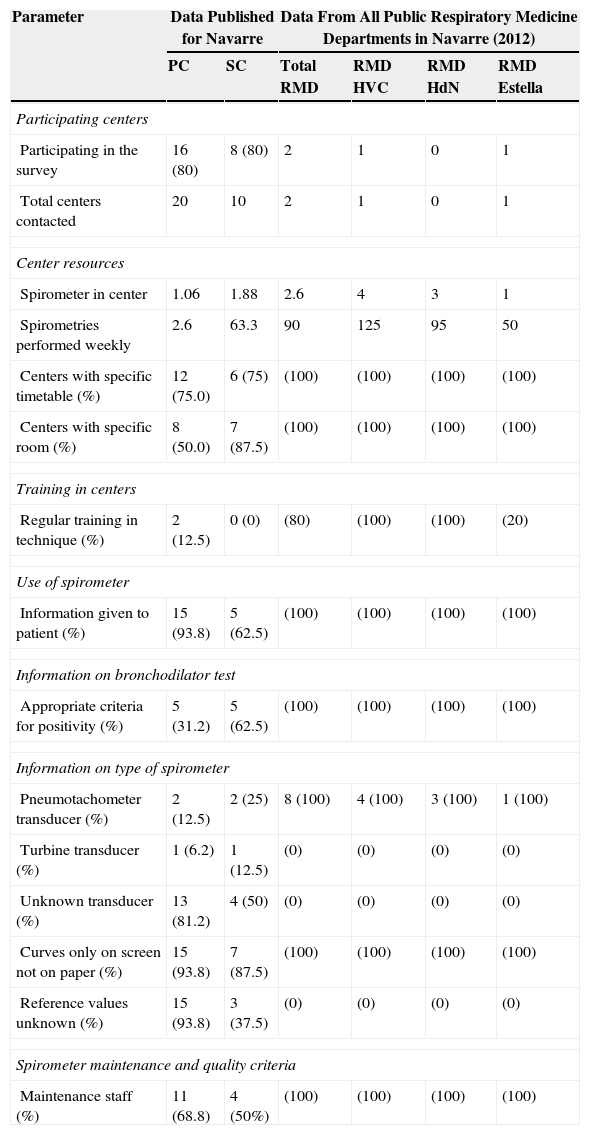We read with interest the study published in the November issue of your journal by Drs López-Campos, Soriano, and Calle,1 addressing inter-regional differences in the conduct and interpretation of spirometries in Spain. The methods section states that the data were obtained from a telephone survey of 805 centers selected randomly from among those routinely assessing adult patients with chronic respiratory disease. The survey was completed by the technician responsible for performing spirometries in each center. We are unaware of how applicable the results may be in other regions, but we would like to point out some discrepancies between the survey results and the data available in our own setting. Indeed, there are stark differences between the authors’ claims and the results of an assessment of spirometry testing in primary care (PC) in our setting that we published in your journal in 2006.2 However, we are even more concerned by their results on spirometry conducted in specialized centers (SC) in 2012 (the year the study was carried out).
In Table 1, we have listed some of the most striking claims made in this article, and compared them with data from all public respiratory medicine departments in Navarre (listed in total, and separately for each of the 3 groups active at that time: Hospital Virgen del Camino, Hospital de Navarra, and Hospital de Estella). It is clear from these data that the results offered in the article of reference do not represent in any way the real situation in our community.
Comparisons Between the Data for Navarre Published in the Article1 and Those Available in Public Respiratory Medicine Departments in 2012.
| Parameter | Data Published for Navarre | Data From All Public Respiratory Medicine Departments in Navarre (2012) | ||||
|---|---|---|---|---|---|---|
| PC | SC | Total RMD | RMD HVC | RMD HdN | RMD Estella | |
| Participating centers | ||||||
| Participating in the survey | 16 (80) | 8 (80) | 2 | 1 | 0 | 1 |
| Total centers contacted | 20 | 10 | 2 | 1 | 0 | 1 |
| Center resources | ||||||
| Spirometer in center | 1.06 | 1.88 | 2.6 | 4 | 3 | 1 |
| Spirometries performed weekly | 2.6 | 63.3 | 90 | 125 | 95 | 50 |
| Centers with specific timetable (%) | 12 (75.0) | 6 (75) | (100) | (100) | (100) | (100) |
| Centers with specific room (%) | 8 (50.0) | 7 (87.5) | (100) | (100) | (100) | (100) |
| Training in centers | ||||||
| Regular training in technique (%) | 2 (12.5) | 0 (0) | (80) | (100) | (100) | (20) |
| Use of spirometer | ||||||
| Information given to patient (%) | 15 (93.8) | 5 (62.5) | (100) | (100) | (100) | (100) |
| Information on bronchodilator test | ||||||
| Appropriate criteria for positivity (%) | 5 (31.2) | 5 (62.5) | (100) | (100) | (100) | (100) |
| Information on type of spirometer | ||||||
| Pneumotachometer transducer (%) | 2 (12.5) | 2 (25) | 8 (100) | 4 (100) | 3 (100) | 1 (100) |
| Turbine transducer (%) | 1 (6.2) | 1 (12.5) | (0) | (0) | (0) | (0) |
| Unknown transducer (%) | 13 (81.2) | 4 (50) | (0) | (0) | (0) | (0) |
| Curves only on screen not on paper (%) | 15 (93.8) | 7 (87.5) | (100) | (100) | (100) | (100) |
| Reference values unknown (%) | 15 (93.8) | 3 (37.5) | (0) | (0) | (0) | (0) |
| Spirometer maintenance and quality criteria | ||||||
| Maintenance staff (%) | 11 (68.8) | 4 (50%) | (100) | (100) | (100) | (100) |
Estella, Hospital de Estella; HdN, Hospital de Navarra; HVC, Hospital Virgen del Camino; PC, primary care; RMD, respiratory medicine department; SC, specialized centers.
As the criteria for qualifying the bronchodilator test and spirometry quality are not explained in the methods section, we cannot compare them with our own data. In any case, the percentages listed (25% in PC vs 12.5% in SC in the first case and 93.5% vs 37.5% in the second) are surprising to say the least. We cannot be sure that they do not reflect procedures conducted in another type of health system, since the type of centers interviewed (public, private, hospital or clinic) is not specified, nor is the specialty that was evaluated (respiratory medicine, internal medicine, allergology, etc.). However, as the authors describe the situation in SC, we believe it is essential to point out that these figures are a poor reflection of the spirometry activities conducted in the public respiratory medicine departments of our region.
Finally, as the authors themselves admit, although telephone surveys enable researchers to reach a large number of centers, the limitations of this type of approach mean that any conclusions must be viewed with caution.
Please cite this article as: Rivas PC, de Heredia JHP. La espirometría en la Neumología pública en Navarra. Análisis contrastado del estudio 3E. Arch Bronconeumol. 2015;51:527–528.










